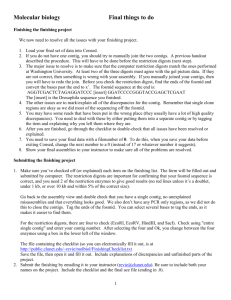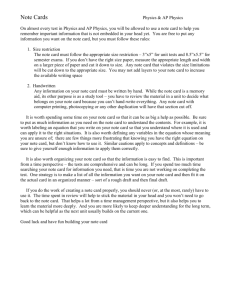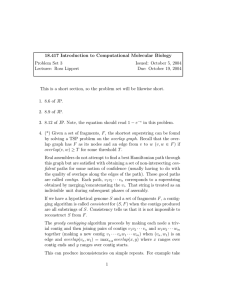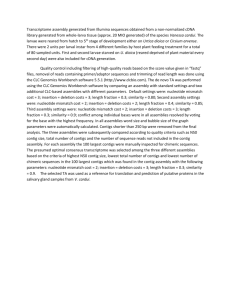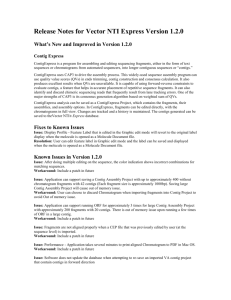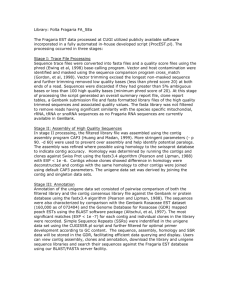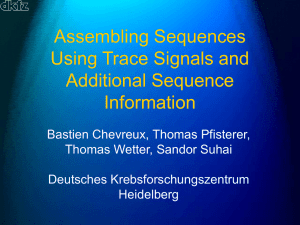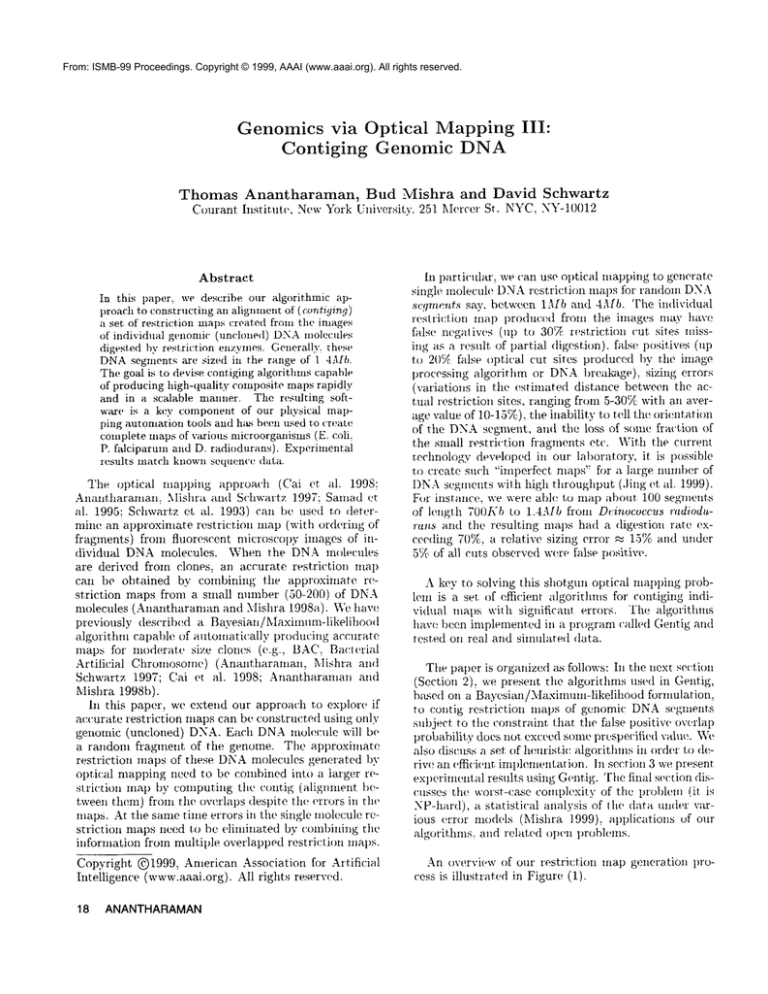
From: ISMB-99 Proceedings. Copyright © 1999, AAAI (www.aaai.org). All rights reserved.
Genomics via Optical h,lapping III:
Contiging
Genomic DNA
Thomas Anantharaman,
Courant
Institute,
Bud Mishra
New ~rk University.
Abstract
In this paper, we describe our algorithmic approacl, to constructing an aligmnent of (contiging)
a set of restriction maps created from the images
of individual genomic (unchmed) DNAmolecules
digested by resl.riction enzymes. Generally, these
DNAsegments are sized in the range of 1 4Mb.
The goal is to devise contiging algorithms capable
of producing high-quality composite maps rapidly
and in a scalable maturer. The resulting softwart, is a key component of our physical mapping automation tools and ha.s been used t.o create
complete maps of various microorganisms (E. coll.
P. falciparum and D. radiodurans). Experimental
l’eSll]tS
match knownseqHent’e data.
The optical
rnapl)ing
approach (Cai et al. 1998;
Ammtharantan. Mishra a.nd Schwartz 199/’; Samad et
al. 1995: Schwartz et al. 1993) can be used t.o deternfine an approximate restriction
map (with ordering of
fragments) from fluorescent
microscol)y images of individual
DNA molecules.
When the DNA molecules
are derived from clones: an accurate restriction
map
can be obtained
by combining the approximate
restriction
maps from a small number (50-200) of DNA
molecules (Anantharaman and Mishra 1998a). We have
previously
described
a Bayesian/Maxinmm-likelihood
algorithm capable of automatically
producing accurate
maps for inoclerate
size clones (e.g.,
BAC, Bacterial
Artiticial
Chromosome) (Anantharaman,
Mishra and
Schwartz 1997; Cai et al. 1998; Anantharaman and
Mishra 1998b).
In this paper, we extend our approach to explore if
accurate restriction
maps van be constructed using only
genomic (uncloned)
DNA. Each DNA molecule will
a random fl’agment of the, genome. The approximate
restriction
maps of these DNAmolecules generated by
optical mapping need to be combined into a larger restriction
map by cmnput.ing the contig (aligninent
between the, m) from the overlaps despite the errors in the
maps.At the same time errors in the single molecule restriction
maps need to be eliminated by combining the
information from multiple overlapped restriction
maps.
Copyright @1999, American Association
Intelligence
(www.aaai.org). All rights
18
ANANTHARAMAN
for Artificial
reserw?d.
and David
251 Mercer St.
Schwartz
NYC, NY-10012
In particular,
we can use optical maI~ping to generate
single molecule DNArestriction
maps tbr ran(tom DN-\
sc~.lm,"nts
sW. between 1Mb and 4Mb. The individual
restriction
nla I) produced froIil the images may have
false negalives (up to 30%. restriction
cut sites missing as a result of partial digestion), fa.lse positives (up
to 20t~: false optical cut sites produced by the image
processing algorithm or DNAbreata~ge), sizing errors
(variations
in the estimated distance between the actual restriction
sites, ranging from 5-30% with an average value of 10-15%), the inability to tell the orientation
of the DNAsegment, and the loss of some fraction of
the small restriction
fi’agments etc. With the current
t.echnology developed in our laboratory, it is possible
t.o create such "imperfect maps" for a large number of
I)NA segments with high throughput (,ling et al. 1999).
For instance,
we were able to map about 100 segments
of length 70()Kb to 1.4Aib from Dcinococc~s radio&,’ra.n.s a.nd the resulting maps had a digestion rate exceeding 70%, a relative
sizing error ~ 15% and under
5% of all cuts observed were false positiw~.
A key to solving this shotgun optical maptfing problem is a set. of efficient algorithnts for contiging individual maps with significant
errors.
The algorithms
ha.ve been implemented in a program called Gent ig and
tested on real and simulated data.
Tt,e paper is organized a.s follows: In the next section
(Section 2), we present the algorithms used in Gentig,
based on a Bayesian/Maximmn-likelihood
formulation,
to contig restriction
maps of genomk: DNA segments
subject to the constraint that the false positive overlap
protoabilil.y does not exceed SOIl)A? prespecified value. We
also discuss a set of heuristic algorithms in order to de,rive an efficient, ilnlflementation. In section 3 we present
experimental results using Gentig. ’rite final see:lion discusses the worst-case complexity of the prolfiem (it. is
NP-hard), a statistical
analysis of tit<, data m,der various error models (Mishra 1999), applications
of our
a.lgorithlns,
and related open I~roblems.
An overview of our restriction
cess is ilhlstrated in Figure (1).
map generation
pro-
i
11114 I~"
colle,~o~ ~nd51rig ol images
I
l
i II
I I
I
I
i
I
I
I I
I
i
I
Constn~ionel rr~ contig(s)
"( ~il : ;i.4".’
1-1:;r::,r:_1
I nl~ i",’,1
...2
1014’.0-"I
IVJ.’L4 : J.
I,,1.1.1x~.i1
IUI~L~.: I
1,,1:i[,’=
=.2_1
Inl ~:J’; I
I
101311:1
I
lu1~,;’:’.. 1
1, ,1:-;’l~.~ _,:
I
I II
I II
i i
i
I II
I II
I II
I
i i
i ii
II
ii
i
!
I
I
l
I
l
i
i
II
i
II
I
i
I
i
i
i
I
i
I
inl t " -~;,_I
J.Oi4 Z 47 i
Iu1~I:¢" l"’
1’ 11i1.’:I,
11
I
I
i
I
I
I
f
i
I
f
I
I
i
i
I
I
I
I
I
i
I
I
I
I
I
I
i
I
i
I
I
I
i
i
I
I
I I
I
II
II
I
I
i
I
I
li
i
I
i i
i
iI
i i
I
I
I
I
I
I
I
|
i
I
I
l
I I
II
i
I
i
i
i
I
I
I
I
i I
i
i
i
I
I
|
i
I
|
I i
i
i
I
II
i
I
II
It
I
i
I
I
I
i
I
i
I
i
i
I
II
i i
Figure 1: Shotgun Optical mapping of genomic DNA
ISMB ’99 19
Algorithms
Scoring Functions
Webegin the description of Gentig with a probabilistic scoring function t.o comparedifferent, possible placements of possible rest fiction mat) overlaps and a heuristic algofit.hm for finding tile placement with the best
score. rhe input to our algorithm is t.he set of (approximate) rest.riction maps to be contiged and a pa.ralneter
denoting a maxinmmaccept.able false positive overlap
probability, specifying the worst-case probability that
I,t!.e
fitia,l
placelnent contains overlaps of mapswhose
DNA’sdo not ill facl overlap.
The scoring flmctior, for a proposed contig has two
(’()lllpOllelltS:
1. A Bayesian probability density estimate for the proposed placement, yielding a measure of goodness of
tit,.
2. At, upper boundestimat.e of the false positive overlap
t)rol)ability
that two unrelated pieces of DNAcould
have produced a Bayesian score as good as in the
I)rot)osed placement.
The pla.n is to maximize t.he Bayesian probability,
density subject t.o never creating contigs whose false
1)ositiv(’ overlap probability exceeds the threshold specified by t.he user. Wedescribe a nmnberof diiferent alg¢)rithms all of which have in (’ommonthat t,hey repeatedly confi)ine two islands that increase the probability
density while having ml a(:(’eptable false positive overlap probability and contitme until no fllrther progress
is possible.
Note t.hat the primary purpose of the false overlap
Ihreshoht is to allow the search of the Bayesian probability density space to proceed in two phases. In the
first phase the maps and resulting contigs may have
many lo(’al errors, the only thing we are sure about
is the approximate location of tile overlaps. For this
t.o work either the quality of the dat.a must be high
or the size of overlapping DNAmust be large (say 0.5
Mb or more of overlap). Enough data must be collected to make up for the fra(:tion (typically 50~.)
data t.hat cannot toe contiged in this phase. In the second phase the cont.ig restriction map can be improved
locally by using gradient methods to optimize the contig hypothesis using methods similar to those described
in (Anantharaman, Mishra and Schwartz 1997). This
would eliminate most of the errors in the input, mat)s.
The input maps discarded in the first phase could lm
t)l;t,:t..(t pr,.)babilistically ell the contig to furtl.er re(hwe
errors, particularly sizing errors, without, alfe(’ting the
overall contig.
In this paper we describe the first phase of the process
which is sutt:icient to allow an approximate restriction
mapto 1)e (’omputed with good error characteristics
shownin lhe resuh.s section.
The algorit.hms use somewhatdifferent strategies for
selecting the pairs of islands to combinenext, and some
allow for backtracking when no fllrther progress is pos20
ANANTHARAMAN
sible to see if an alternate selection strategy wouldproduce a different/bett, er solution.
Since speed is critical for this application, some
approximat.iorts are used in the computation of t.he
Bayesian probability which are unlikely t.o affect the
contigs but may result in slightly subot)timal contig
fragment size est.imates. Oncethe final cont.ig has been
determined better contig fragment size est.imates could
be obtained toy performing a more exact. Bayesian probability maximization with the contig fragment sizes a,s
parameters.
The Bayesian Probability
Density Estimate
The Bayesian probability density estimate for a proposed placement is an approximation of the l)robability
density that t.he two distinct component maps could
have been derived from the proposed placement a,s a
result of various data errors. The data errors we model
inch]de sizing errors, missing restriction cut sites, attd
/al.se optical cuts sites. Tile Bayesian probabilit.y density estimate is computedin two steps:
1. The most likely alignment (orientation and placement) for the two comt)onent maps is comImted.
2. The best contig hypothesis corresponding to the most.
likely alignment is computed.
The Bayesian probal)ility
density computation here
is sinfilar
to that in (Anantharaman, Mishra and
Schwartz 1997) with only two maps to combine, except
that we approximate the computation to some extent.
a~s explained earlier. In particular, we approximate the
following:
1. The best contig hypothesis is comput.ed by" a simple averaging of the contiged fragment sizes (using
linear interpolation for missing cuts) from the best
possible aligmnent, rather than a true Bayesian probability density., maximization with fragment sizes as
parameters. This avoids the expensive global m,d local optimization over possible contigs as t)erformed
in (Anant.haraman, Mishra and Schwartz 19971).
’2. Good estimates of the global error model parameters
are assumedto be knowna priori: tout will be t’urt.her
improved by using a. limited number (2-31) of iterations of a Bayesian probability densit.y mm’vimization
st.ep over all contigs.
Whenthe input data consists of genonfic optical
maps computed from single instances of DNAfragments t.his ~Lpproximation may sometimes change the
computedset. of islands. But, by, using a strict enough
false positive overlap probability threshold, only the
best data. will be contiged together, and hence the result.ing island(s) should give a correct, estimate of those
parts (of the actual contig supported by" t.he best data.
The posterior conditional probal)ility density for
hypothesized placement "H, given the maps, consists of
the product of a prior probability density for the hypot.hesized placenmnt and a conditional density of the
errors in the component maps relative to the hypothesized placeinent. Let the -’~i input maps to be contiged
be denoted by data vectors Dj (1 < j _< ill) specifying tile restriction site locations and enzymes. Then
tile Bayesian probability density for "~/, given the data
can be written using Bayes rule as in (Anantharanlan,
Mishra and Schwartz 1997):
M
f(.HiD,...
D,,,)
:tl
= IU-/) 1-IZ(DsI’H)/I-I
j::l
M
]’(Do)
j=l
.:v f(7/)
l-If(Dj]H).
f(~) = (x/~)’,
./=1
Not(, that for any reasonable error inodel, the probability density of the se(’ond term monotonically decreases as more and more maps are contiged, since the
Illunbcr
of lnislnatches
increases
as nlore
nlaps
pected false cut density in the input maps, and is
assumed to be uniformly and randomly distributed
over tile input maps.
The Bayesian probability density components f(?-/)
and f(Dj[’H) are computed separately for each contig
(island) of tile proposed placement and the overall probability density is equal to their products. For computational convenience, we actually compute a penalty function, A, proportional to the logarithm of the probability
density as follows:
are con-
*iged (ov"rlat)ped). Thus the only way the probability
density for a contig could t)e better than the probability density of its individual componentsis, if there is a
strong prior bias in favor of producing more overlaps,
reflected in the first componentf(7/) (the prior density
of 7/).
Weapproximate the prior probability f(7-/) as a decreasing function of the total cont.ig length. In particular, we set the logarithm of f(?-/) to be proportional
-(KX), where X is the total length of contig hypothesis $/, and K is a constant. A larger K corresponds
to a greater bias in favor of smaller total contig length
(with greater overlaps). Note that, for good data the
final contig is be stable over a fairly wide range of K
values, since the errors due to excessive (and therefore
incorrect) overlaps should be nmchgreater than for correct overlaps. Thus,it. is possible t.o find this region
by increa,sing t( gradually until the islands remain unchanged for several successive K values. On the other
hand, with some knowledge of the total length of the
islands, one could adjust K until the computed total
length is approximately of this length. Wehave found
that the most convenient and quickets way of setting K
is to estimat(, the value of K that would exactly balance the expected decrease in probability density from
correct overlaps (given the error parameters) and setting K t.o somesmall nmltiple (typically 1.5-2.0) of this
value to allow for someoutliers in errors.
Tile conditional probability density function f(Dj ]7-/)
depends on the error model used. Wemodel the following errors in the input, data:
1. Each orientation is equally likely to be correct.
2. Each fl’agment size in data Dj is assumed to have
an independent error distributed as a Gaussian with
standard deviation a.
3. Missing restriction sites in input maps Dj are modeled by a probability Pc of an actual restriction site
being t)resent in the data.
4. False restriction sites in the input maps Dj are modeled by a rate parameter P:, which specifies the ex-
\J=~
Here m,j is the number of cuts in input map Dj. The
prior component of A for each contig is simply 2KXa",
where X is the length of the island, and K a constant
as discussed earlier. The other components of A can be
con,t)uted for each island and then summedup.
For fragment sizing errors, consider each fragment
of the proposed contig, axed let the contig fragment be
composed of overlaps from several map fragments of
length rl, ..., rN. Ifp~ = 1 and p] = 0 (the ideal situation), it is easy to showthat the hypothesized fragment
size p and the penalty A are:
P_
Z)~ri
I---74~-,
and A = ~(ri
N
- #)2.
i---=1
In addition if there is an overlap of this fragment by
a partial map fragment of length rp > #, we add an additional penalty to A equal to (rp-/,)2/2 for the largest
such partial map fragment for each contig fragment.
Nowconsider the presence of missing cuts (restriction
sites) with p~ < 1. To model the multiplicative error of
p~ for each cut present in the contig we add a penalty
A~ = 2a2 log[1/p~] and to model the multiplicative error of (1 - Pc) for each missing cut in the contig we
add a penalty A,, = 2or" log[l/(1 - Pc)]- The alignment
determines which cuts are missing, and the method for
finding the best aligmnent is described later.
The computation of i, is modified in the case of missing cuts by assuming that the missing cuts are located
in tile samerelative location (as a fraction of length)
in overlapping maps that do not have the corresponding cut missing. Also, the penalty for partial map fragments is modified in order not to exceed the A., since it
is nowpossible that. a real restriction cut site is missing
in the partial map fragment.
Finally, consider the presence of false optical cuts
when p/ > 0. For each false cut (as determined by the
alignment in the proposed placement) we add a penalty
A f = 2a2 log[1/(pivf~a)] in order to model a multiplicative penalty of p/and the absence of one 1/(v/-~a)
tern] normally present in the Gaussian error term.
Additionally, the penalty for the partial map fragments must now be bounded by the possibility that the
partial map fragment is correct and the corresponding
ISMB ’99 21
- exp(--pc(Xi q- 2Di)/f)),
Di = fl’agment size error rela.t.ive
to previous aligmnent,
Xi = smaller of distances to previous cut
of same enzyme on eithe," map, and
f./p<. = expected distance between cuts
of same enzyme.
shorter
internal
fraginents
aligned
against
itallhavea
false
(:llt.
The False
Positive
Match Probability
The score function corresponding to the false positive
overlap is based oi1 an estimate of the false positive
match score S~,p , the ratio of the probability that a
random DNAwould have matched better than the actual DNAmap (ill terms of of the Bayesian penalt,
score) to the probability t.hat random DNAwould [lave
matched worse than the actual DNAmap. If one is
considering Mmaps to contig, and thus looking at, (’?)
pairs of mapsto contig, a conservative strategy to keep
the false positive overlap probability for the best pair
of mapsbelow the user specified level of FP is to require
each contig’s S. to be below ,,,/(’~’).
The Mlse positive match score SFp for a pair of maps
to be contiged is approximated as the product of the
above probability ratio for each fragment in the contig,
which is estimated as follows:
Let the average fragment size be t and the fragment
size distribution be modeled by the exponential distritmtion f(x) = exp(-x/~)/L If the maps to be contiged
have restriction sites for multiple enzymes, one would
model each restriction
enzyme by a sepm’ate value of
to exploit the differences bet.ween rare cutting arid
frequent cutting enzymes.
First assume that Pl = 0 and p~ = 1 (tile ideal sit.uation). Consider two maps or contigs being considered
for potential ove.rlap, and let the fragment sizes in the
overlap region be x~, ..., Xg and Yt .... , Yx, respectively. Also, let. the two maps/contigs contain a total of
N~ aaM Nu fragments, respectively. Then allowing for
two orientations and at most (Nz + v -2N+ 1) possible alignments with that many overlapping fragments,
one can estimate an upper bound for the false positive
match score SF, by integrating over the ways that each
pair of fragment sizes could be. ~ close as they are by
mere chance:
s,,,, =2(N~
+N.~- 2:V+t) II 1 - p(:<,y~)’
i=l
where p(xi, Yi) = exp(-Xi/t) - exp(-(Xi
and Xi = Inin(xi:
Yi), D, = ]xi - y/[.
2Dd/r),
For partial map fragments of size xv overlapping an
internal fragment of size #, tile value of S~., can be
further reduced, by allowing for the fact t.hat the partial
fragment has a true size of at. least :%.
If we have missing cuts with p,. < 1, &..,, is modified
as follows. Let. n~,nu be the number of actual cuts in
the overlap region of the two mapsrespect.ively, and let
m be the number of those that are aligned:
SFe = 2(.’N~
fi
p(xi,
Yi)
- nx + Ny - ny + 1) 17~)i)’
i=1
where p(xi, yi) = coa(ELp~])(exp(-p~Xi/g)
22
ANANTHARAMAN
E[pc] is a local estima.te of p,,. obta.ined by counting the nmnber of misaligned cuts (of each enzyme
type) between the current and previous cut aligmnent.
Coll(E[pc]) is a I)essinfistic estiInate of t, he nunlber
times ;lf consecutive identical alignnlents wouht in(’rea.se the number of ways equally good alignment.s
(wit.h :’tl total aligned fragments) could be achieved
chance with ra.ndonl DNA.This expression can be derived by considering Midentical consecutive alignments
such as the current one and counting the number of
ways Mor rnore restriction site alignments (other than
the leftmost alignment) couht be obtained by choosing
Mof the M/g[p,:] possible alignments sites of one of
the molecules to align with random sit.es in the other
molecule. Taking the AI ~h root of this number as
M -+ ~ results in CoR(E[p~]). The expressi(m for
partial end fragments is derived similarly.
If false cuts are presen~ (pf > 0), an upper bound of
~’~FP Ca1/be
obtained by treating all false cuts as real cuts
with the corr(.’sponding matching cuts all missing and
using ~/(Pc + @.f) as the (apparent) average distance
between two consecutive cuts of the saine enzyme in
the previous expressions.
Global
Search
As meilt, ioned earlier, the heurist.ic global search for
the best I)lacement is based on repeatedly combining
those two islands that produ(:e the greatest increa:se in
Bayesian conditional posterior probabiliw density and
excluding any contig whose false positive overlap probability is unacceptable. The algorithm stops when there
no longer is any pair of islands that can l)e combined
to improve the probability density with acceptable false
positive overlap probability. The final cont.ig set is then
used to estimate more accurate values for the parameter
o-,p/and p~.. If these significantly differ h’omthe known
input values, tile entire global search is repeated. Our
initial experiments showthat only a few (typically just
two) iterations suffi(’e for the global sere’oh, given good
initial values for a, Pc and PYOne property of our global seardl heuristic is thal,
it is greedy in combining pairs of maps/contigs and
therefore maybe suboptimalif the data qualit, y is l)oor.
However,tile false positive threshold will auroniatically
reduce the amount, of contiging if the data quality is
poor: hence the use of a gree.dy search is sufficient if all
data errors were modeled.
Wehave since discovered that there is a very small
chance that an input mapis actually a c(mlbination of
two pieces of DNAthat just happened to lie end-toend in the image (Optical Chimerism). In such cases
greedy search strategy can get stuck in a sub-optimal
local maxima. To handle such un-modeled errors, the
final contigs are analyzed for statistically unlikely distributions in the contig depth : Any contiging errors
are likely to result in very shallow contigs at the error
location, if these errors are low probability events. Configs can then be broken up at these shallow points and
the input maps that formed the bridges at these points
discarded and then further contiging attempted. This
provides a simple form of back-tracking that is sufficient to recover from low probability missing terms in
the error model.
Overlapping
Islands
by Dynamic
Programming
Finding the best offset and alignment between a pair
of maps is potentially exponential in complexity since
each cut site in one map could be aligned with almost
any cut site in the other map. The solution is to use
a dynamic programming algorithm for finding the best
alignment between a single molecule map and a map hypothesis. The problem here is different from finding the
best alignment of a data map against a hypothesis map,
as described in (Anantharaman, Mishra and Schwartz
1997). Here we have two maps and each possible alignment of the two maps generates a contig hypothesis
which determines the Bayesian score of the two maps.
Consider two input data maps or contigs Di and
Dj. Let the locations of the restriction site cuts on
the input data be Xa... X~m, and Xjl ....¥jm i . Denote the length of the maps by Li and Lj respectively.
For the Dynamic Programming formulation we define
three tables Pig, LIj and RIj of size I = 1...ra~ by
J = 1... mj. Their values are defined to be:
1. PIJ : For all alignments of D i and Dj such that cuts
Xis and ~¥jg are aligned, the least possible penalty to
the right of X~I and Xjj in the best such alignment.
2. Ltj : For all alignments of Di and Dj such that cuts
XiI and Zjg are the left most aligned cuts, the least
possible penalty to the left of Xil and Xjj.
3. RI3 : For all alignments of Di and Dj such that cuts
X~Iand .¥jj are the right most aligned cuts, the least
possible penalty to the right of X~I and Xjj.
Wefirst compute LId and RIj for all possible I and
J by computing the penalty for the remaining (misaligned) cuts in the overlap end region specified. For
each cut choose from amongst three alternate explanations the one with the least penalty : The cut is a
false penalty, (A f) or the cut is missing from the other
map (Ac + An) or the cut matches the end of the map
((rp - #)2/2). For input maps (not contigs) this
written as :
rn i
LI
j
-~
y~ (Xii - X~, >_ Xjj - X j0)?0
n=l+l
min(Al, A~ + A,,
(-Yil
--
Win
-
Xjj
+
Xjo)2/2)
mj
+ ~ (Xjj -.¥j, > X. - Xi0)?0
~=J+l
min(Af, A~+ A., (Xj.I - Xjt - X~I + Xio)2/2)
I--1
RI
J "~-
E(Li - Xm> Lj - X)j)?0
tI=l
min(Ai,,%+ A~,(L, - X,~- L~+ XjA"/2)
J-I
+Z(Lj - Xit > Li - X~I)?0
t=l
rain(A f, A~ + A~, (Lj - X3t - LiXjj + Xi~ )2/2)
The table PIJ is computed using dynamic programming : For each pair of aligned cuts I and J we consider
all possible combinationsof the next pair of aligned cuts
n, t to the right of I, J :
PIJ : min(RIj,
min
l+l<n<n~i
rain [(Xin -- XiI -- A’jt + Xjj)2/2
J+l<t<mj
+(n- I- 1 + t - J- 1)min(A/,A~ + AN)l)
Wealso remember the best. next alignment n and t
for each I,J (or NIL if RIj was the least penalty term)
To find the best alignment, we just need to locate its
leftmost alignment I, J given by the smallest possible
sum PIJ + LId over all I: J. The next alignment is then
given by the remembered best values of n and t which
can be iterated to determine the entire alignment.
Whencombining contigs of maps rather than input
maps, the Dynamic programming structure is the same,
except that the exact penalty values are slightly different aald computed as the increase in penalty of the
new contig over the penalty of the two shallower contigs being combined. The expressions for computing the
penalty of deep contigs has been described previously.
The resulting algorithm has a time complexity of
O(m2m~)in the worst, case. However one can incorporat.e heuristics to bring downthe average case complexity to O(mi + rtlj):
1. The probability that. two pairs of aligned cuts are
separated by very manyunaligned cuts is very small,
which ’allows the number of n and t values that need
to considered in computing Pzd to be limited to some
small constmlt number. In practice one could linfit
the total number of misaligned cuts between pairs of
aligned cuts to no more than about 7, resulting in
8 x 9/2 = 36 pairs of n and t values. This reduces
the complexity for large mi arid mj to O(minb).
2. All aligned cuts in the best alignment will correspond
to similar offsets between the maps/contigs. This
means that all the good (low) penalty scores in the
ISMB ’99 23
PI.] table will lie along some diagonal (n~t necessarily the center diagonal). It, is possit)le to locate
the. approximateoffset value that t, his diagonal corresponds to by filling in only a small region of the
table P~j corresponding to large [ or large d values,
then only compute those remaining elements of PIJ
with similar offset values. This reduces the complexity to O(mi + mj).
This dynanlic programming needs to be combined
with a global search that. tries aal possible pairs of tile
:’I[ input maps for possible owMat)s. This could add
:~) : checkworst case multiplicative complexity of O(M
ing 0(:~[") pairs of maps to find the next pair m combine, and doing this ()(,,1I) times. Moreover,the overall
:~), where n is the average
complexity then is not O(nM
mmfl)er of cuts per input map, but. O(n"M3), if tile
contigs are grown from one side adding one new map
1+~) by the
at a time. This can be improved to O(nM
following hem’istics :
1. The next pair of nmps to combine can be determined by using a hashing scheme suggested by Dennis
Sha.sha, which will be detailed in a subsequent publi(:ation. It. allows all pairs of matchingmapsto be.
deternfined ill O(11.:~,:/l+~) time. where e ranges from
0 to 1 depending on the severity of the error process
(e = 0.25 is typical for the errors we encounter).
2. By combining maps, so that all nmI)S/contigs remain
of comparable size, the total time to compute all
O(M) alignments becomes O(u* Mlog(M)), since the
combination effectively involves O(log(M)) phases in
which all maps are combined in O(nM) tiIne (their
total size). Combiningthis with the complexit.y for
hashing, we get the previously st.ated total complexity.
Experimental
Results
We, first, present, someresults of experiments with Gentig using data from Chromosoine 2 of Plasmodium falciparum. The results have been veritied from availal)le
sequen(’e data.
The data flom Chromosome2 of Plasmodiwm yah:iparum had l)reviously been collected by .Junping .ling
for the BamHlrestri(’tion
enzyme (Jing et al. 1999),
and used to manually assemble a contig over a period
of several weeks. The same data was also run through
Genrig and produced esse.ntially the same contigs in a
matter
of a few seconds. The contig also agrees with
the sequence data t.llat has since becomea.vailat)le. All
three contigs are shown in the table below, wkh fragment sizes in kilobases.
24
ANANTHARAMAN
Method
Manual
Assembly
Contig
Program
Sequence
Data
77.1 19.9 7.5 26.1 9.9,11.0 12.4
3.7 34.8 21.1 62.2 49.7 43.5 74.6 47.2
80.8 2.0 8.9 18.6 80.8 19.9 31.1 17.4
28.6 52.2 2.0 24.9 6.0 34.8
79.8 19.6 6.9 26.1 10.9 45.3 13.7
4.0 31.9 19.5 58.2 49.9 34.0 54.3 51.6
82.2 2.1 10.7 18.3 81.0 19.8 28.9 17.7
27.8 49.6 2.1 25.2 5.6 38.9
77.5 21.0 6.8 27.1 9.8 43.3 13.6
3.7 36.0 20.2 61.8 55.2 40.8 70.3 46.9
87.3 1.8 11.6 18.0 84.0 20.7 30.4 18.0
30.8 50.0 1.8 24.8 5.3 28.1
Nol.e float a major difference in the mapsis in the size
of the right end fragment. The sequence data shows a
siualler right end fragment. Howeveri~ is knownthat
the telomeric regions near the chromosomeends are full
of repeats and therefore probably compressed by the
sequence assembler. Conversely Gentig appears to produce end fragment size estimates that are slightly larger
than the MaamalAssembly. The reason is that Gentig
(lid not model chromosomeends and actually returns
the largest, vahw. in the sample for each end fragment,
on the assumption that the contig might continue on either end. In contrast the manual assembler recognized
the end fragment.s and averaged their size.
Complete restriction maps of all 14 chromosomesof
Plasmodium ]alciparum for the BamHIrestriction
enzyme: were computed from a single set of genomic DNA
molecules: 12 of the chromosomes were automatically
identified as separate contigs by Gentig, and the remaining 2 chromosomes appeared as 2 cont.igs each,
which could be identified based on the knownapproximate sizes of the chromosomes.Similar maps of all 14
chromosomeshave also been computed for the NheI enzyme. These maps are published in their entiret.y elsewhere, but are not shown here since only chromosome
2 can be verified from sequence data.
To test the effectiveness of the software on larger
genomes, simulated data was created for a genome of
length 20Mbfrom which segments were sampled of random length in the range of 1--3Mb located randomly
along the genome.Restriction sites for the specific enzyme ACGTTGAC
(8-cutter, non-palindromic restriction
sequence, chosen at random) were located in each segment (subject to error). The restriction fragment sizes
of average length 5(}Kb were further raaMomly scaled
to produce a sizing error in the fragments with a stan(lard deviation, ~ ~. 3Kb (equivalently, a 95%error of
+12%). Restriction sites were randomly omitted (removed)for a sinmlated digestion rat(: of p~ 0. 80 and
randomly located false cuts were introduced on all segments at a rate of 1 per Mb (p/ = 10-s). The experiments were conducted on three sets of dat.a according
to the specifications described here. The mmlberof segments in each set were varied to include 40, 80 and 160
segment maps corresponding to a. coverage c of 4x, 8x
and 16x, respectively.
The actual number of contigs present and the computed number of contigs are shown in the following table. The largest contig was checked against the simulated genometo locate any errors, arid none was found.
[I Theoretical
Coverage, c
Contigs
Longest
contig
Computed
Contigs
Maps
Rejected
Longest
contig
Est. SD, a
Est. pc
Est. pf
It is easily seen that in order for the false negative
probability to be small, it is required that
k< np4cO
- 2
and r >_pc
kl
4,
k1~2.
4
4
12,248
Kb
8
2
15,599
Kb
16
1
19,849
Kb
Thus, if in fact input maps Di and Dj overlap by 0,
then we will detect it with probability bigger than
4
0
2
0
2
1
12,251
Kb
2.99 Kb
0.815
-~
0.6 x 10
15,601
Kb
2.96 Kb
0.808
-~
0.9 x 10
19,963
Kb
3.00 Kb
0.805
-5
0.9 x 10
Nowconsider the false positive probability and consider an arbitrary alignment (not necessarily satisfying
the constraints on the unmatched prefixes). Let the
random variable Wdenote the number of fragments in
input map D~ that positionally match with the fragments of input map Dj. Note that
(1 - e-k’)(1 e- nP~°lS).
Conclusion
The Worst-case Complexity
Note that the Bayesian approach inherent to the Gentig algorithm relies heavily on the knowledgeof a good
prior distribution of the errors: partial digestion, false
cuts and sizing errors. In the absence of this information, the worst case behavior of any algorithm to
solve tile genomiccontiging problem is likely to be exponential. In particular, there are pathological examples (consisting of artificially constructed input maps)
for which this problem can be shown to be NP-hard by
a transformation from the HaIniltonian path problem
for a cubic graph. The proof of this theorem is rather
technical and is given in the appendix.
Statistical
Analysis of Feasible Errors
Wewant to understand how the feasibility
of our genomic contiging approach w~ries with parameters in the
error models. In order to bound the range of error parameter values for which unique solutions to the contiging problem exist., it. is instructive to examinea rather
simple overlap rule. Weshall consider two importaat
parameters: the relative sizing error, .’3 and partial digestion rate p~. For the sake of simplicity, we assume
that the number of true restriction fragments in each
input restriction map is n and number of detected restrict.ion fragments, rn. = npc. The "overlap threshold
ratio" (the minimumfraction of one input map, in base
pairs, that. has to be overlapped by the other input map
to recognize the overlap) is denoted by 0. A low 0 value
is desirable to achieve a contig with low coverage.
The overlap rule that we exanfine here takes tile partial digestion into account. The rule is fairly simple and
as follows: Consider an alignment, where input map Di
is "aligned with respect to another input map Dj with
an overlap ratio bigger than 0 (in 4 possible relative
orientations); at least k of the restriction fragments of
the input maps match positionally and the numbers of
unmatchedfl’agments in the prefixes are bounded by r.
i!
By Brun’s sieve, we see that
Prob[W = i] = -’°npJ2.
~.(~npc/2)ie
Thus the false positive probability is
o~ 1
i=k
and we need to make r as small as possible and k as
large as possible, in order to guarantee that the false
positive probability remains small.
Hence, we need to satisfy the following constraints:
3flnp~ < k < np4~O
1
kl
and
<r <:j.
---i-
Thus
2
3’3
l>0>~-~p3
arid
,’3
5
3
Thus our approach of contiging genomic optical maps
works well when the partial digestion probability is
rather high (close to 1), i.e.,
p~ _ (3:q/2)½.
or the relative sizing error is quite low.
Applications
The algorithms described in this paper together with
the optical mappingprocedure can be used to construct
genome wide restriction maps in a rapid and scalable
manner without using any cloning and requiring very
little DNAsample. This has a number of interesting
applications.
First the genome wide restriction maps can be used
for sequence verification.
Since the maps have long
ISMB ’99 25
range fidelity, they will not reflect errors due to repeats (unless the repeats are larger than about 1-4
Megabases).
Second, the genome wide restriction
nlaps can be
used in sequence assemMy. Since any reasonably large
sequence contig (say 10 kb or longer) can t.ypically
placed uniquely on a multi-enzyme genonle wide restriction map, this allows the gaps in the Sequence assenlbly
to be pin-pointed accurately.
Finally, the ability to rapidly construct genomewide
restriction maps opens the possibility to nlaking meaningful population genolnic studies without doing any sequencing. For example large scale DNAinsertions and
deletions such as occur in cancer (:ell lines, compared
to non-cancerous cell lines, could be detected just. by
comparing their genonmwide restriction nlaps.
Open
Problems
AmongInany renlaining related unsolved problems~ t.he
hies( interesting one involves the situation where, optical
maps to be contiged are those coming from K potmlalions. If (.he populations of DNAhave restriction maps
that are sutficiently different from each other this would
be no different t.hall the current protflem of comtmting
the restriction mapof an entire genomewith lnultiple
chromosomes.However if some of t.he nmlnbers in th(~
population are very similar, they may be combined into
the same cont.ig or even into two eontigs involving erroneous crossovers. A conlnlon example is to be able to
distinguish the diploid chromosomal pairs. The same
problem has been studied %1" optical maps from clones
in (Mishra and Parida 1998).
Other open problems include the ability to model
missing fragments: systematic sizing error (an entire
DNAmolecule has all its fragInents too laa’ge or too
small), the ability to use additional side information
from the optical inapping process (such as whenthe size
of a particular fragment is likely to be less reliable).
Acknowledgement
s
Our thanks go to C. Aston, J. Jing, J. Lin, Z. Lai and
R. Qi of Keck Laboratory, Chemistry Department for
the genomic maps and the contigs for Plasmodium rid_
ciparum (chromosoine 2), S. Pm-<ia of Courant Institute
and Z. Lai for the help with the map display and to
E. Huff of Chemistry Department for the help with the
synthetic data used in testing the software. Our thanks
also go to D.J. Carucci and S.L. Itoffman of Naval medical Research Insti~ut.e and to M. Gardner, H. Tettelin,
L.M. Cummingsand J.C. Venter of Tile Institute for
Genomic Research for providing the sequences used in
the experimental verification of the Gentig algorithm.
The research presented here was partly supported by
an NSF Cm’eer grant: IRI-9702071, an NItI Grant: NItI
R01 HG0025-07 and a grant from the Chiton Corporation.
26
ANANTHARAMAN
Appendix:
Worst
Case Complexity
Weare assumed t.o be given M intervals (genomic DNA
segments)
Dr, D.2 ..... DM,
each of length L and ea(’h containing n. cut sites (ell.her
true restriction cut sites ,.)r false opti(:al cut sites; sizing
error is ignored in the discussion of the complexity).
For instance, the cut. sites on the jth interval Dj are
given a.s
0 < Cjl.
< (’j2
< "’"
"(
Cjn
<
In the k)llowing complexity analysis, we assume that
we are given an external i)arameter, Pc E [0, 1] that
represents the digestion rate.
Our goal is t.o place these Mintervals on the real
line by fixing the alignnmnt (the orientation and the
position of tile left, end) of each interval. By D j, we
denote the interval Dj after it. has been placed on the
real line; and by Interval(D j), the interval spanned
Dj after it. has been placed. For any such pl>u:ement of
the intervals, every comwcte(1subinterval of the union
of the placedintervals (i.e., [..J lnterwfl(Dj)) is isl and:
any island that is not a singleton interval is a contig.
A pla(:ement is admissible if tim union of the placed
interval is connected (i.e., there is only one contig).
For any" placement we define a coulposite map
0 < ml < m2 < "" < m.h’,
such that there is a. cut at position mi in the composite
nmpiff the fraction of the placed intervals straddling
mi (m.i E Interval(D j)) that has a cut mi (.mE DO)
exceeds the parameter p,..
[{m.i ¯ Dj}I
>p,..
I{m.i C Int.erval(Dj)}l
Notice that every adnfissible placement induces a pernmtation of the intervals D.-r([), Dr.(’,), ..., D.~ MJ
ternfined by the placementof t.he left. ends of the intervals (with any reasonable rule for tie-breaking). Define
a met.rio of goodness for an adnfissible placement by
.k(D1,D.e,...,Dal)
= nlin I{mi E D~(j) ,~.Daij_t)}[.
I<j<M
Weare interested in exploring the following decision
problem:
GENOY..IIC CONTIG (G(])
PaomA.:.M:
Given: :ll intervals Dl, D2 .... , DM,each of length
L and each containing n cut sites: a rational number
Pc C [0, 1]; and a desired goodness given try a natural
nunlber k > 3.
Determine: If the intervals allow an adnfissible placement such that
v(DI,D.2 .....
DM)>
Theorem 0.1 The problem GC is NP-hard.
Proof. Wegive a simtfle transformation fi’om llarniltonian path problenl restric.ted to a cubic graph (Garey
and Johnson 1979). Given a cubic graI)h G = (1.;
with IVI = Mand ]EI = 3M/2, we create Mintervals,
one for each vertex as follows: Corresponding to vertex
vj, we create an interval Dj = [0, 18] that has exactly
k(> 3) cut sites in each of the subintervals [3, 4], [4, 5],
[,5, 6], [12, 13], [13, 14] and [14, 15]. Let tile three edges
incident at. vj be
ejl = vjv3t ,
e j2 = vft 4 and eia = t,jv~.
Let
and
Tile cut locations are then
3 +xj~, 3 + 2xj~ .... , 3 + kxj,,
4 + x j:, 4 + 2xja,..., 4 + kxj2,
5 + xja, 5 +2xja .... ,5 + kxja,
12 + xjl , 12 + 2xj,,...,12
+ kxjl
,
13 + xj.~, 13 + 2xj,,...,
13 + kxj2,
14 + xj.~, 14 + 2xja,...,14
+ kxja
).
3
Wechoose the desired goodness t.o be k and Pc = ~.
Suppose G has a Hanfiltonian path from vt to vM
which may be assumed to be (after suitable renumbering)
UI,V2,...
,VM-
It is fairly straightforward to create an admissible
placement of D1 through D.~I such that at aay location at most two placed intervals Interval(Dj) and
Interval(Dj+l)
overlap. Furthermore, the composite
map contains exactly the k cuts in Djn Dj+l and correspond to the edge vjvj+l in the Hamiltonian path.
Thus for this admissible placement
x(D1,D2,...,DM)
=k,
References
ANANTItAR.AMAN AND B. M]SHRA, "Genomics
via Optical MappingI: Probabilistic Analysis of Optical Mapping Models," NYUtechnical report 1998-770,
August 1998.
T.S.
T.S.
ANANTHARAMAN,
B.
MISHRA
AND
D.C. SCHWARTZ, "Genomics via Optical Mapping II:
Ordered Restriction Maps," Journal of Computational
Biology,4(2) :91-118, 1997.
T.S. ANANTHARAMAN
AND g. MISHRA, "Genomics
via Optical Mapping II(A): Restriction Maps from
Partial Molecules and Variations," NYUtechnical report 1998-759, March 1998.
W. CAI, ET AL.,
"High-Resolution
Restriction
Maps of Bacterial
Artificial
Chromosomes Constructed by Optical Mapping," Proc. Natl. Acad. Sei.
USA,9S:3390-3395, 1998.
M.R. GAREY AND D.S.
JOHNSON, "Computer and
Intractability:
A Guide to the Theory of NPCompleteness," W.H. ~feeman and Co., San Francisco
1979.
J. JING, ET AL., "Optical Mapping of Plasmodium
/alciparum Chromosome2)’ Genome Research,9:175181, 1999.
E.g.
LANDER AND M.S. %VATERMAN, "Genomic
Mapping by Fingerprinting
RandomClones: A Mathematical Analysis," Genomics, 2:231-239, 1988.
B. MISHRA,"Algorithmic Biology," Courant Lecture
Notes Series, 1999 (Tent.).
B.MmURA
ANDL. PAPdDA, "Partitioning
K-Clones:
Inapproximability Results and a Practical Solution to
the K-Population Problem," Recomb 98,192-201, 1998
A. SAMAD ET AL.,
"Mapping the Genome One
Molecule At a Time---Optical
Mapping," Nature,
378:516-517, 1995.
D.C. SCIIWARTZ ET AL.,
"Ordered Restriction
Maps of Saccharomyces cerevisiae ChromosomesConstructed by Optical Mapping," Sciences, 262:110-114,
1993.
M.S. WATERMAN, "All Introduction
to Computational Biology: Maps, Sequences and Genomes,"
ChapmanHall, 1995.
as desired.
Conversely, we need to show that if D1, ..., DMallow
an admissible placement D1, ..., DMwith a goodness
of k or higher, then the resulting permutation ~ induced
by the positions of the left ends of the placed intervals
gives a Hamiltonian path
Vrr(1),.--,’t)s
~---UTr(j),
Vt Yn(j+l’),’"V,v(M)"
",
Suppose
thatit isnota Hamiltonian
path,i.e.,forsome
j, vs = v,-r(j) and vt -- v=(j+l) are nonadjacent in
Then it is rather easy to see that ]{D~(j)ND=(j+I)}]
2; thus, contradicting the assumption that the initial
placement has a goodness of k or nmre. []
ISMB ’99 27

